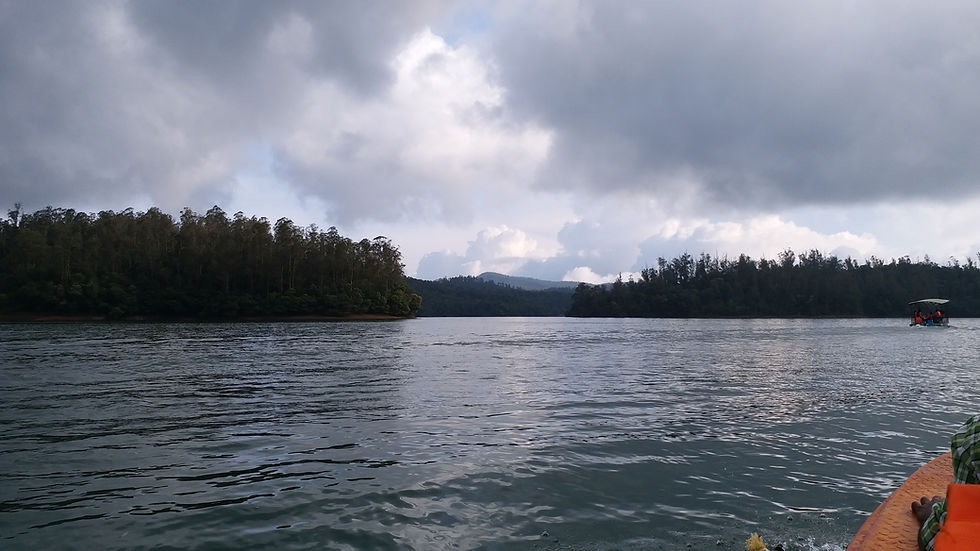Whether it is "HUM AAPKE HEIN KAUN (HINDI)," "KSHANA KSHANAM (Telugu)," or the eternal "GEETHANJALI (TELUGU & TAMIL)," a wave of nostalgia washes over me when I hear the songs from these fantastic films. They transport my soul to a winter wonderland, Where the entire landscape is enveloped with dense fog at dawn, while the same is covered by low-hanging dark clouds hovering over slowly accompanied by a slow-paced cool breeze filled with mist as dusk approaches. This place is none other than the beautiful hill station called "Ooty."

About:
Udhagamandalam, commonly known as Ooty, stands as a popular tourist destination in the southern region of India. This town offers captivating landscapes in the Nilgiris district (Kongu Nadu region, Tamilnadu), nestling atop the Nilgiris mountain range. These mountains are located in Western Ghats and stretch across Tamilnadu, Karnataka, and Kerala. The term "Niligiri" originates from the Tamil language, where Nil signifies Neelam (BLUE), and Giri translates to Mountain, hence referred to as The Blue Mountains. Interestingly, The neighboring state of Andhra Pradesh shares the same interpretation in Telugu Language. These azure blue Mountains are home to hill stations such as Ooty, Coonoor, and Kotagiri. Among these, Ooty is hailed as the "Queen of hills." Standing at an elevation of approximately 7349 feet (2240 meters) above sea level, Ooty boasts lush green dense forests with thriving diverse wildlife habitats. This tiny, beautiful town covers an expanse of around 30.36 square kilometers.

The region is predominantly inhabited by the Badagas tribe, alongside other ancient tribes like Todas, Kotas, Kurumbas, Panias, and Irulas. Throughout history, these majestic mountains witnessed the reign of powerful Tamil dynasties such as the Cheras, the Cholas, and the Pandyas.
Etymology:
In its early days, the region was known as "Ottaka Mandu," meaning single stone, a reference to a respected and worshipped sacred stone in the region. Over time, the name evolved to "Udhagamandalam," later anglicized to "Ootacamund" by the British Empire. Eventually, the name was shortened to "Ooty," the familiar term used today. However, residents of Tamilnadu and the locals still favor the name "Udhagamandalam" over "Ooty."
Nature and Habitat:

The Blue Mountain Hills boast Neelakurini or Kurinji plants, which bloom only once every twelve years with purple-blue flowers. When these blooms happen, it feels akin to a vivid blue carpet draping over the entire mountain, a visual feast for the eyes. Additionally, Ooty is renowned for hosting some of India's most extensive Coffee and Tea plantations, thriving alongside dense pine and eucalyptus trees. Historically, it's said that the Britishers introduced Eucalyptus, Pine, and Wattle trees to the Nilgiri Hills. Before their arrival, the entire region was abundant with native vegetation like grasslands and meadows. Today, the dominant species on the Nilgiri mountains are Pine, Eucalyptus, and Wattle trees invading the native vegetation.

Since Ooty is located on the highest points of the Western Ghats, the town receives heavy rainfall during the southwest and northeast monsoons. Annually, this town receives an average of around 43.30 inches or 110 millimeters of rainfall. Because of its high altitude, Ooty features a subtropical highland climate, letting the temperatures vary between O - 21 degrees Centigrade (32 - 70 Fahrenheit) in winter and 10 - 25 degrees Centigrade (50 - 70 Fahrenheit) in summer. The lowest recorded temperature was -5.1 degrees Centigrade (22.8 Fahrenheit).
Wildlife habitats like smaller faunas, deer, bears, and monkeys are native to these mountains, while the dense forests are also known as home to their largest Bengal Tiger populations and elephants.
Places of interest:

Ooty Lake, Pykara Falls, and the dam are some places to visit. The Botanical Garden Ooty and Rose Gardens are a must for garden lovers. They boast more than 20,000 varieties of Roses and many exotic plants, Shrubs, Ferns, Trees, Herbs, and Bonsai plants. The Ooty Lake is a man-made reservoir spanning across 22 acres, constructed in 1824. Pyakara, a natural river situated approximately 19 kilometers away from Ooty, originates from Mukurthi Peak. Cascading through the terrains, it winds up into two distinct falls collectively known as Pykara Falls. The Botanical Garden occupies an area of 22 acres.
Comments